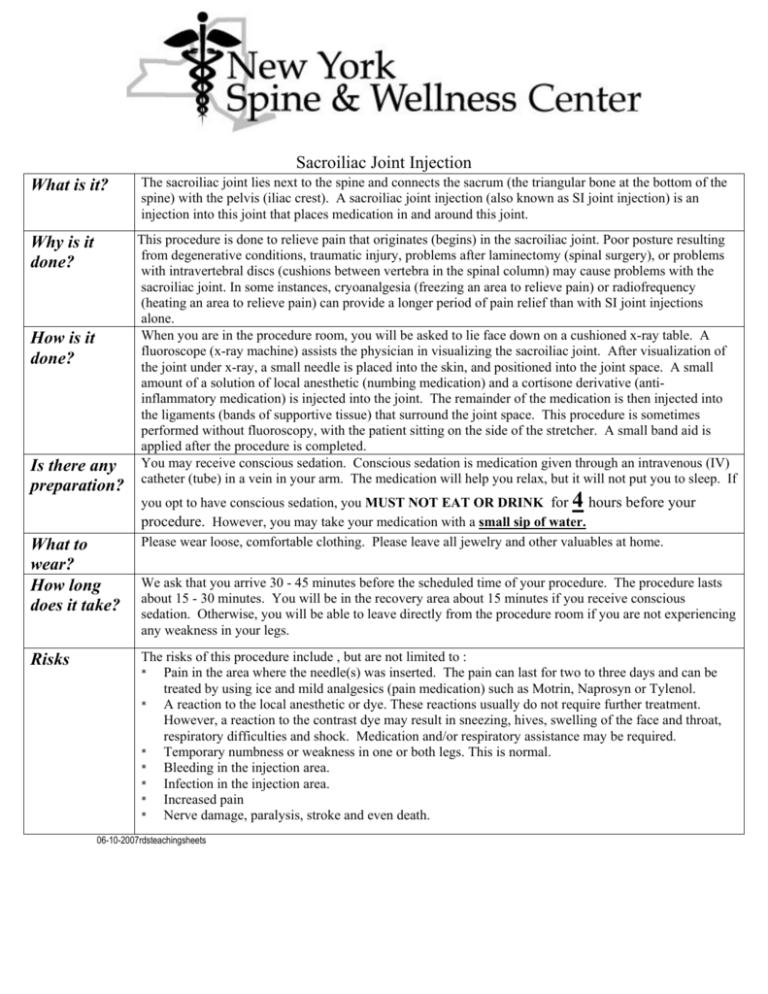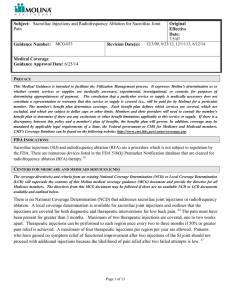Sacroiliac Joint Injection What is it? Why is it done? How is it done
advertisement

Sacroiliac Joint Injection What is it? The sacroiliac joint lies next to the spine and connects the sacrum (the triangular bone at the bottom of the spine) with the pelvis (iliac crest). A sacroiliac joint injection (also known as SI joint injection) is an injection into this joint that places medication in and around this joint. Why is it done? This procedure is done to relieve pain that originates (begins) in the sacroiliac joint. Poor posture resulting from degenerative conditions, traumatic injury, problems after laminectomy (spinal surgery), or problems with intravertebral discs (cushions between vertebra in the spinal column) may cause problems with the sacroiliac joint. In some instances, cryoanalgesia (freezing an area to relieve pain) or radiofrequency (heating an area to relieve pain) can provide a longer period of pain relief than with SI joint injections alone. When you are in the procedure room, you will be asked to lie face down on a cushioned x-ray table. A fluoroscope (x-ray machine) assists the physician in visualizing the sacroiliac joint. After visualization of the joint under x-ray, a small needle is placed into the skin, and positioned into the joint space. A small amount of a solution of local anesthetic (numbing medication) and a cortisone derivative (antiinflammatory medication) is injected into the joint. The remainder of the medication is then injected into the ligaments (bands of supportive tissue) that surround the joint space. This procedure is sometimes performed without fluoroscopy, with the patient sitting on the side of the stretcher. A small band aid is applied after the procedure is completed. You may receive conscious sedation. Conscious sedation is medication given through an intravenous (IV) catheter (tube) in a vein in your arm. The medication will help you relax, but it will not put you to sleep. If How is it done? Is there any preparation? you opt to have conscious sedation, you MUST NOT EAT OR DRINK for 4 hours before your procedure. However, you may take your medication with a small sip of water. What to wear? How long does it take? Please wear loose, comfortable clothing. Please leave all jewelry and other valuables at home. Risks The risks of this procedure include , but are not limited to : * Pain in the area where the needle(s) was inserted. The pain can last for two to three days and can be treated by using ice and mild analgesics (pain medication) such as Motrin, Naprosyn or Tylenol. * A reaction to the local anesthetic or dye. These reactions usually do not require further treatment. However, a reaction to the contrast dye may result in sneezing, hives, swelling of the face and throat, respiratory difficulties and shock. Medication and/or respiratory assistance may be required. * Temporary numbness or weakness in one or both legs. This is normal. * Bleeding in the injection area. * Infection in the injection area. * Increased pain * Nerve damage, paralysis, stroke and even death. We ask that you arrive 30 - 45 minutes before the scheduled time of your procedure. The procedure lasts about 15 - 30 minutes. You will be in the recovery area about 15 minutes if you receive conscious sedation. Otherwise, you will be able to leave directly from the procedure room if you are not experiencing any weakness in your legs. 06-10-2007rdsteachingsheets







